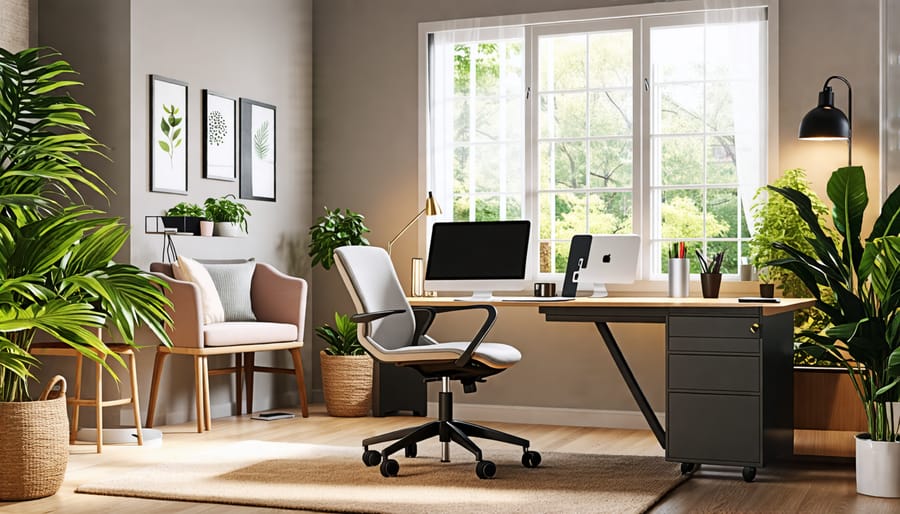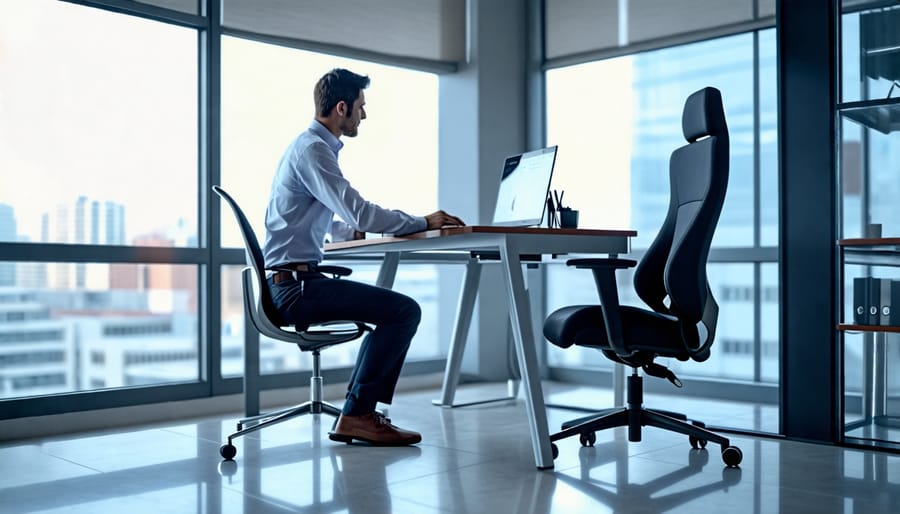
Is Your Home Office a Pain? 5 Ergonomic Tweaks for All-Day Comfort
Position your desk and chair to maintain proper posture, with your monitor at eye level, elbows bent at 90 degrees, and feet flat on the floor. Invest in an ergonomic chair with lumbar support and adjustable height and armrests to reduce back strain. Incorporate small space home office ideas like wall-mounted shelves, vertical storage, and compact furniture to maximize comfort in limited square footage. Take frequent breaks to stretch, move around, and rest your eyes, aiming for at least 5 minutes every hour to prevent repetitive strain injuries.

Desk and Chair Setup
Choosing an Ergonomic Chair
When selecting an ergonomic chair for your home office, look for key features that promote proper posture and comfort. Lumbar support is crucial for maintaining the natural curve of your lower back, reducing strain and fatigue. Adjustable armrests allow you to position your arms at a comfortable height, minimizing shoulder and neck tension. Seat depth is another important consideration; the chair should allow a 2-3 finger gap between the back of your knees and the seat edge to ensure proper leg support. An adjustable backrest lets you fine-tune the angle to your preferences, while a chair with tilt tension control enables you to adjust the resistance when reclining. Breathable fabric or mesh promotes air circulation, keeping you cool during long work sessions. Chairs with adjustable seat height are essential for aligning your feet, knees, and hips properly. Opt for a chair with smooth-rolling casters suitable for your flooring type to make moving around your workspace effortless. By prioritizing these ergonomic features, you can create a comfortable and supportive seating environment that enhances your productivity and well-being in your home office.
Desk Height and Placement
When setting up your home office desk, aim for a height that allows your elbows to bend at a 90-degree angle when typing. This typically falls between 28 and 30 inches for most people. If your desk is too high, consider using a footrest to maintain proper posture. Seated desks are the most common, but standing desks have gained popularity for their potential health benefits. If you opt for a standing desk, ensure it can be adjusted to the proper height and alternate between sitting and standing throughout the day to avoid fatigue.
Position your desk perpendicular to windows to minimize glare on your computer screen. If this isn’t possible, use blinds or shades to control the amount of natural light entering the room. When it comes to artificial lighting, aim for a combination of overhead and task lighting to reduce eye strain. Place your desk lamp on the opposite side of your dominant hand to avoid casting shadows while writing. By optimizing your desk height and placement, you can create a comfortable and efficient workspace that promotes good posture and reduces the risk of strain or injury.
Computer Screen Positioning
Properly positioning your computer screen is crucial for maintaining good posture and reducing strain on your neck and eyes. The top of your screen should be at or slightly below eye level, so you can view the entire screen without tilting your head up or down. This helps keep your neck in a neutral position. Aim to position the screen about an arm’s length away from your body. If the text appears too small at this distance, increase the font size rather than moving the screen closer.
The screen should also be centered in front of you to avoid twisting your neck or torso. If you use multiple monitors, place the primary screen directly in front of you and the secondary screens adjacent to it. Tilt the screen slightly upward, around 10-20 degrees, to minimize glare and maintain a comfortable viewing angle.
Laptop users face unique challenges when it comes to screen positioning. The screen and keyboard are attached, making it difficult to achieve the proper height for both. One solution is to use an external keyboard and mouse, allowing you to elevate the laptop screen to the correct eye level. Alternatively, you can place your laptop on a stand and use an external monitor as your primary screen. Remember to take frequent breaks and look away from the screen every 20 minutes to reduce eye strain.

Keyboard and Mouse Ergonomics
When it comes to keyboard and mouse ergonomics, proper arm and wrist positioning is crucial for maintaining comfort and preventing strain. Your arms should be bent at a 90-degree angle, with your wrists straight and relaxed while typing or using the mouse. Avoid resting your wrists on the desk or keyboard tray, as this can put pressure on the nerves and cause discomfort over time.
Consider investing in an ergonomic keyboard and mouse to further enhance your comfort. Ergonomic keyboards are designed with a split layout or curved keys to promote a more natural hand position, reducing the risk of repetitive strain injuries. Similarly, ergonomic mice come in various shapes and sizes to fit your hand comfortably and minimize wrist strain.
Placement of your keyboard and mouse is equally important. Position your keyboard directly in front of you, centered with your body, and at a height that allows your arms to remain at a 90-degree angle. Your mouse should be placed close to your keyboard, within easy reach, to avoid overextending your arm or shoulder. Experiment with different keyboard and mouse positions to find what feels most comfortable for you.
Remember, these ergonomic essentials are key to creating a workspace that promotes comfort, reduces strain, and enhances your overall productivity. By prioritizing proper arm and wrist positioning and investing in ergonomic peripherals, you can create a home office environment that supports your well-being and helps you work more efficiently.
Lighting and Eye Comfort
Good lighting is essential for maintaining eye comfort and reducing strain in your home office. Aim for a balance of ambient and task lighting to create an even, glare-free environment. Ambient lighting, such as overhead fixtures or wall sconces, provides general illumination for the room. Task lighting, like desk lamps or under-cabinet lights, focuses on specific work areas and helps minimize shadows.
When choosing light bulbs, consider the color temperature. Warm white bulbs (2700-3000K) create a cozy atmosphere, while cool white bulbs (4000-5000K) simulate daylight and can boost alertness. Experiment to find the right balance for your space and preferences.
Position your computer screen to avoid glare from windows or light fixtures. If necessary, use blinds, shades, or adjustable lighting solutions to control natural light. Matte screen filters can also help reduce reflections.
Proper lighting ergonomics not only prevents eye strain and headaches but also enhances productivity and well-being. Take regular breaks to rest your eyes, and consider the 20-20-20 rule: every 20 minutes, look at something 20 feet away for at least 20 seconds. By optimizing your home office lighting setup, you’ll create a more comfortable and efficient workspace that supports your health and work performance.

Conclusion
Creating an ergonomic home office is crucial for maintaining comfort, productivity, and overall well-being while working from home. By making small adjustments to your workspace, such as ensuring proper chair height, monitor placement, and keyboard position, you can significantly reduce strain and discomfort. Remember, investing in ergonomic equipment and taking regular breaks to stretch and move around can make a world of difference in your daily work experience. For further inspiration and guidance, explore resources on creating a zen home office environment that promotes both physical comfort and mental clarity. With a little effort and attention to detail, you can transform your home office into a space that supports your health, happiness, and professional success.
